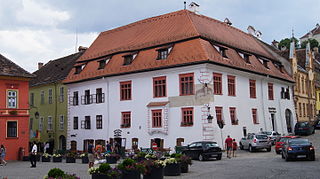
Sighișoara is a municipality on the Târnava Mare River in Mureș County, central Romania. Located in the historic region of Transylvania, Sighișoara had a population of 23,927 according to the 2021 census. It is a popular tourist destination for its well-preserved old town, which is listed by UNESCO as a World Heritage Site. The town administers seven villages: Angofa, Aurel Vlaicu, Hetiur, Rora, Șoromiclea, Venchi, and Viilor.

Mămăligă is a polenta made out of yellow maize flour, traditional in Romania, Moldova, south-west regions of Ukraine and among Poles in Ukraine, the Black Sea regions of Georgia and Turkey, and Thessaly and Phthiotis, as well as in Bulgaria (kačamak) and in Greece. It is traditional also in Italy, Switzerland, Southern France, Slovenia, Croatia, Brazil, with the name polenta.
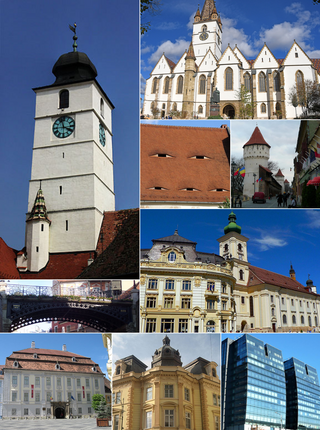
Sibiu is a city in central Romania, situated in the historical region of Transylvania. Located some 275 km (171 mi) north-west of Bucharest, the city straddles the Cibin River, a tributary of the Olt River. Now the seat of Sibiu County, between 1692 and 1791 and 1849–65 Sibiu was the capital of the Principality of Transylvania. Until 1876, the Hecht hause in Sibiu served as the seat of the Transylvanian Saxon University.

The Transylvanian Saxons are a people of mainly German ethnicity and overall Germanic origin —mostly Luxembourgish and from the Low Countries initially during the medieval Ostsiedlung process, then also from other parts of present-day Germany— who settled in Transylvania in various waves, starting from the mid and mid-late 12th century until the mid 19th century.
Romanian cuisine is a diverse blend of different dishes from several traditions with which it has come into contact, but it also maintains its own character. It has been influenced mainly by Turkish but also a series of European cuisines in particular from the Balkan Peninsula and Hungarian cuisine as well as culinary elements stemming from the cuisines of Central Europe.

The Germans of Romania represent one of the most significant historical ethnic minorities of Romania from the modern period onwards.

Biertan is a commune in Sibiu County, Transylvania, Romania. The commune is composed of three villages: Biertan, Copșa Mare, and Richiș, each of which has a fortified church.
The Democratic Forum of Germans in Romania is a political party organised on ethnic criteria representing the interests of the German minority in Romania.
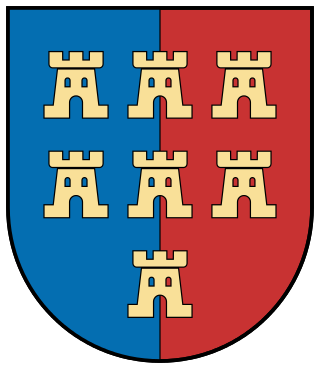
Transylvanian Saxon is the native German dialect of the Transylvanian Saxons, an ethnic German minority group from Transylvania in central Romania, and is also one of the three oldest ethnic German and German-speaking groups of the German diaspora in Central and Eastern Europe, along with the Baltic Germans and Zipser Germans. In addition, the Transylvanian Saxons are the eldest ethnic German group of all constituent others forming the broader community of the Germans of Romania.

The Landlers or Transylvanian Landlers are an ethnic German sub-group which has been living on the territory of today's Romania, more specifically in southern Transylvania since the 18th century onwards.
The Association of Transylvanian Saxons in Germany is a German organization formed in 1946 by Transylvanian Saxons who were resettled in Germany from Transylvania. Its goals are the integration of Transylvanian Saxons in Germany and the preservation and promotion of the Transylvanian Saxon culture. It is based in Munich, Bavaria, southern Germany, and has over 25,000 members. It was renamed from the "Landsmannschaft der Siebenbürger Sachsen in Deutschland" in 2007.

Șeica Mare is a commune located in Sibiu County, Transylvania, Romania. It is composed of six villages: Boarta, Buia, Mighindoala, Petiș, Șeica Mare, and Ștenea. Calvaser was also a village until the late 20th century, when it was absorbed by Șeica Mare village.

Valea Viilor is a commune located in Sibiu County, Transylvania, Romania. It has a population of 1,873, and is composed of two villages, Motiș and Valea Viilor. Each of these has a fortified church, Motiș fortified church and Valea Viilor fortified church. Both places were established and long inhabited by Transylvanian Saxons.

Băgaciu is a commune in Mureș County, Transylvania, Romania. It is composed of two villages, namely Băgaciu and Deleni.

The Diploma Andreanum, or Der Goldener Freibrief der Siebenbürger Sachsen, was issued by King Andrew II of Hungary in 1224, granting provisional autonomy to colonial Germans residing in the region of Transylvania of the then Kingdom of Hungary, more specifically the present-day area of Sibiu, central Romania.

The Principality of Transylvania, from 1765 the Grand Principality of Transylvania, was a realm of the Hungarian Crown ruled by the Habsburg and Habsburg-Lorraine monarchs of the Habsburg monarchy and governed by mostly Hungarians. After the Ottomans were ousted from most of the territories of medieval Kingdom of Hungary, and after the failure of Rákóczi's War of Independence (1703–1711), the Habsburg dynasty claimed the former territories of the Principality of Transylvania under the capacity of their title of "King of Hungary". During the Hungarian Revolution of 1848, the Hungarian government proclaimed union with Transylvania in the April Laws of 1848. After the failure of the revolution, the March Constitution of Austria decreed that the Principality of Transylvania be a separate crown land entirely independent of Hungary. In 1867, as a result of the Austro-Hungarian Compromise, the principality was reunited with Hungary proper.
Transylvanian Landler is a German dialect of the Transylvanian Landler community who lives in Sibiu County in southern Transylvania, central Romania. Transylvanian Landler is a southern dialect of the German language and has many linguistic features in common with Bavarian. It is estimated that approximately 1,500 people speak this dialect of German at a native level.
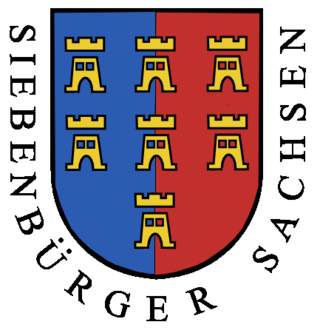
The Transylvanian Saxon University was an official governing body of the Transylvanian Saxon community in Transylvania during the Late Middle Ages up until the late Modern Age. The Saxon University was led by the Saxon Count.

The Transylvanian Saxon literature is a form of literature which represents the totality of literary works written in the Transylvanian Saxon dialect and Standard German by various Transylvanian Saxon writers in the passing of time. These literary works include both those written in prose and in the lyric genre, from folk tales to poems and prayers. Additionally, the Transylvanian Saxon literature, in a larger sense, can also included works written by Transylvanian Saxon writers in Latin and Romanian.
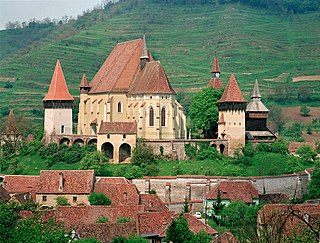
The Transylvanian Saxon culture refers to the regional culture of the Transylvanian Saxons, an ethnic German group which has been living in Transylvania, present-day central Romania since the mid and mid-late 12th century onwards, thus being one of the oldest groups of the German diaspora still residing in Eastern and Central Europe, alongside the Baltic Germans and the Zipser Germans.

























